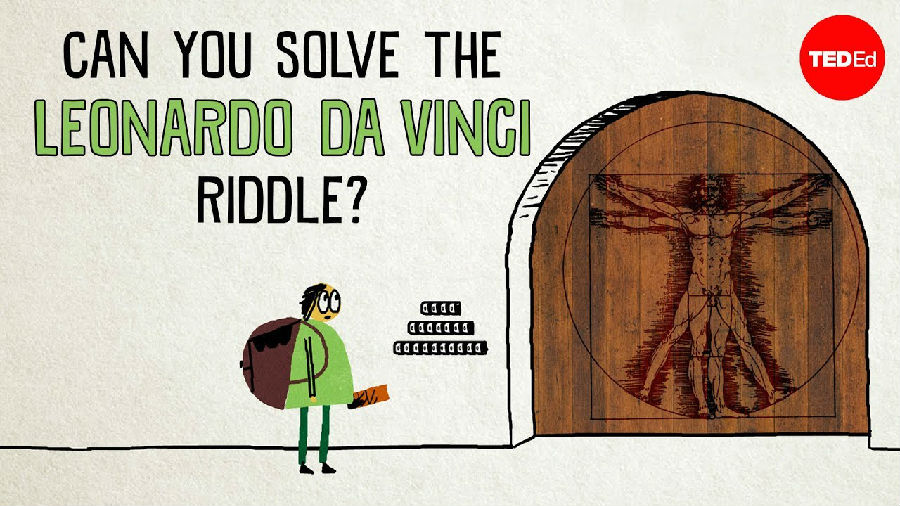You've found Leonardo Da Vinci's secret vault, secured by a series of combination locks.
你找到了列奥纳多·达·芬奇的秘密地下室,地下室门口有一连串密码锁。
Fortunately, your treasure map has three codes: 1210, 3211000, and... hmm.
幸运的是,你的寻宝地图上有三串密码:1210,3211000,还有,呃...
The last one appears to be missing. Looks like you're gonna have to figure it out on your own.
最后一串好像看不清了。看起来你只能自己推断一下这串数字了。
There's something those first two numbers have in common: they're what's called autobiographical numbers.
前两串数字有一些相似之处:这种数字叫作“自我描述数”。
This is a special type of number whose structure describes itself.
其特点是能够描述本身的数字结构。
Each of an autobiographical number's digits indicates how many times the digit corresponding to that position occurs within the number.
自我描述数的每一位数字代表了这一位置对应的数字在整个数中出现的次数。
The first digit indicates the quantity of zeroes, the second digit indicates the number of ones,
第一位数表示数字0的个数,第二位数表示数字1的个数,
the third digit the number of twos, and so on until the end.
第三位数表示数字2的个数,之后的位数以此类推。
The last lock takes a 10 digit number, and it just so happens that there's exactly one ten-digit autobiographical number. What is it?
第三行锁有十位数,巧合的是,正好有唯一的十位的自我描述数。这个数是多少呢?
Blindly trying different combinations would take forever.
盲目尝试不同数字组合恐怕要试到地老天荒。
So let's analyze the autobiographical numbers we already have to see what kinds of patterns we can find.
所以我们先分析一下已有的这两组自我描述数来看看我们能找到什么规律。
By adding all the digits in 1210 together, we get 4 -- the total number of digits.
把1210的每位数加起来得到的和是4。
This makes sense since each individual digit tells us the number of times a specific digit occurs within the total.
这个结果的意义在于,每一位数字告诉了我们特定一个数字在整数中出现的次数。
So the digits in our ten-digit autobiographical number must add up to ten.
所以我们的这个十位数的自我描述数,每一位数加起来的和一定是10。
This tells us another important thing -- the number can't have too many large digits.
这同时告诉了我们另一个关键信息--这个数字不能有太多的大数。
For example, if it included a 6 and a 7, then some digit would have to appear 6 times,
比如,假如这个数字有一个6和一个7,那么有的数字需要出现6次,
and another digit 7 times -- making more than 10 digits.
另一个数字要出现7次--这样加起来就超过了十位数。
We can conclude that there can be no more than one digit greater than 5 in the entire sequence.
所以我们可以判断出整个十位数里不会有超过一位大于5的数。

So out of the four digits 6, 7, 8, and 9, only one -- if any -- will make the cut.
所以在6,7,8,9这四个数中,最多只能出现一个,才能满足这一标准。
And there will be zeroes in the positions corresponding to the numbers that aren't used.
而且,这十位数里会有0,代表了没有用到的数字。
So now we know that our number must contain at least three zeroes -- which also means that the leading digit must be 3 or greater.
所以现在我们知道了这个数至少要有三个0--这就意味着首位数不能小于3。
Now, while this first digit counts the number of zeroes, every digit after it counts how many times a particular non-zero digit occurs.
既然这个首位数表示0出现的次数,那么在它之后的每一位数表示的就是一个非零数出现的次数。
If we add together all the digits besides the first one -- and remember, zeroes don't increase the sum
如果我们把首位数后的每位数都加起来--注意,0不会影响总和,
we get a count of how many non-zero digits appear in the sequence, including that leading digit.
我们会得到整个十位数中非零数出现了多少个,包括首位数。
For example, if we try this with the first code, we get 2 plus 1 equals 3 digits.
举个例子,如果我们把第一串数这样加和,我们得到2+1=3,三个数。
Now, if we subtract one, we have a count of how many non-zero digits there are after the first digit -- two, in our example.
那么如果我们减1,就会得到在首位数之后出现的非零数的个数,在这个例子中也就是2。
Why go through all that? Well, we now know something important:
为什么要这么处理数字呢?注意,我们现在掌握了一个关键信息:
the total quantity of non-zero digits that occur after the first digit is equal to the sum of these digits, minus one.
在首位数后出现的非零数的总数等于这些数的总和减1。
And how can you get a distribution where the sum is exactly 1 greater than the number of non-zero positive integers being added together?
那么你要如何得到一个数,使它的各位数之和正好比非零正数的总和大1呢?
The only way is for one of the addends to be a 2, and the rest 1s. How many 1s?
唯一的办法是使加数之一为2,其余的都是1。那么是多少个1呢?
Turns out there can only be two -- any more would require additional digits like 3 or 4 to count them.
看起来只能有两个1,因为一旦超过两个,就会出现3或4等其他的数字用以表示1的出现次数。
So now we have the leading digit of 3 or greater counting the zeroes, a 2 counting the 1s, and two 1s
所以现在我们知道第一位数是不小于3的表示0出现次数的数,还有表示1出现次数的数字2,还有两个1,
one to count the 2s and another to count the leading digit.
表示2出现的次数,还有另一个表示第一位数出现次数的数。
And speaking of that, it's time to find out what the leading digit is.
说到这里,我们应该来推断一下首位数了。
Since we know that the 2 and the double 1s have a sum of 4, we can subtract that from 10 to get 6.
既然我们知道2和两个1的总和是4,我们可以用10减掉4,得到6。
Now it's just a matter of putting them all in place:
现在就是如何排列它们的问题了:
6 zeroes, 2 ones, 1 two, 0 threes, 0 fours, 0 fives, 1 six, 0 sevens, 0 eights, and 0 nines.
六个0,两个1,一个2,零个3,零个4,零个5,一个6,零个7,零个8,零个9。
The safe swings open, and inside you find... Da Vinci's long-lost autobiography.
守护之翼张开,走进去你发现了...达芬奇失传已久的自传。


